

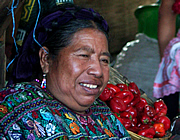
Antigua is a lovely city with a colourful market, easy to explore and with some good food too.
Iximche was our first Mayan site, relatively unknown, very peaceful and quite atmospheric. The Mayan ceremony was a fascinating chance experience.
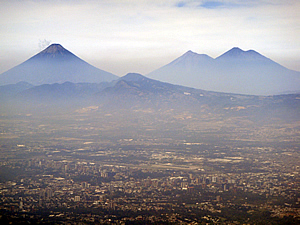
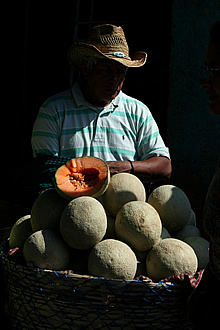
Flying into Guatemala CIty we could see volcanoes to the north and further towards the coast. Antigua is set between three fantastic volcanoes: Agua (3765m) to the south and Acatenango (3976m) and Fuego (3763m) to the west. Mostly these are dormant, though Fuego has been known to emit a smoky plume occasionally.
Antigua was the capital city of Guatemala until a great earthquake in 1773 created much damage. Today it is a lovely small city. We were particularly taken by the low buildings - there is very little higher than two storeys. In its day, though, it was very fine with many impressive buildings and though much has been destroyed through natural disaster it is gradually being restored to reflect some of its former grandeur.
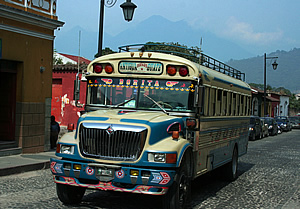
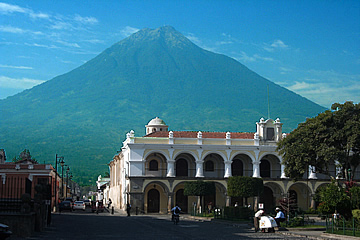
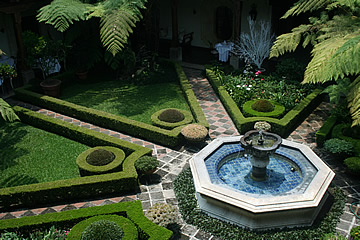
We were met by our guide and driver, Mario, who turned out to be the nicest person and the best guide we've had anywhere. He was supremely knowledgeable and went out of his way to make sure we had a really good time.
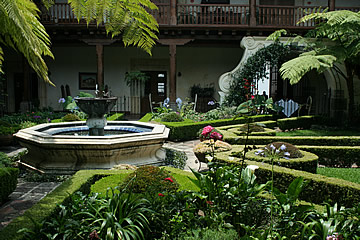
Mario drove us to Antigua, pointing out coffee trees on the way and telling us the history of the lovely hotel we were staying at - the Hotel Palacio de Doña Leonor.
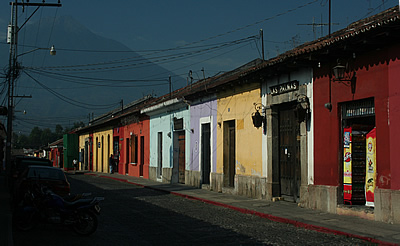
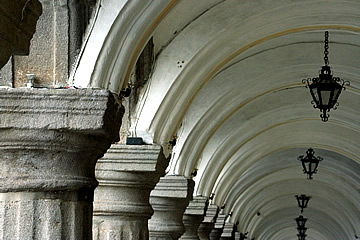
Doña Leonor de Alvarado was the mestizo daughter of the conquistador Don Pedro de Alvarado and the Tlaxcalan Indian princess “Tecuilhuatzin” (“Doña Luisa”). She lived in this small palace with her husband and six children, the rooms are named after family members. We were welcomed outside the hotel by the manageress and a good number of staff, including the chef!
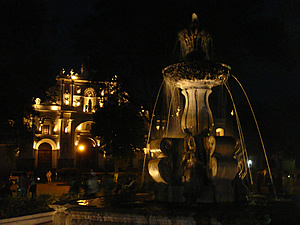
It is a gorgeous hotel, only eight bedrooms arranged on the first floor around a beautiful courtyard with tiled, splashing fountains, green plants and flowers. Breakfast (fabulous Eggs Benedict!) and evening meals could be taken at tables on the edge of the courtyard - the food was excellent. Our room was "Paula" opulent in red with beautifully carved wooden columns, original ox blood tiles on the floor, heavy velvet curtains and moulded ceiling and a large gleaming bathroom.
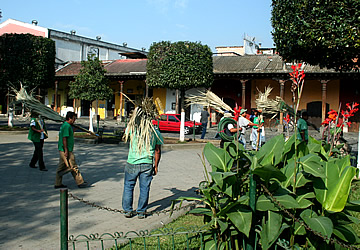
Alvarado was Cortés' second in command and had a reputation for cruelty and violence, for instance he was responsible for the massacre of Aztec nobles in the Mexican city of Tenochtitlan in 1520.
He was trusted to conduct campaigns through Central America including the conquest of Guatemala. He became Governor of Guatemala until his death in1541. In 1543 the colonialists named Santiago de los Caballeros the capital of Guatemala - present day Antigua.
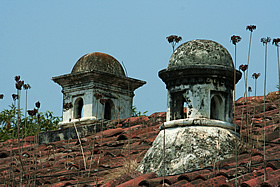
Antigua is an easily explored city, we wandered from end to end discovering colonial churches and civic buildings. The centre of the city is a large green square, Plaza Mayor or Parque Central, where people congregate under the shady trees.
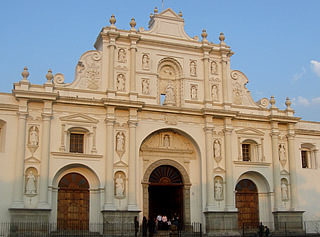
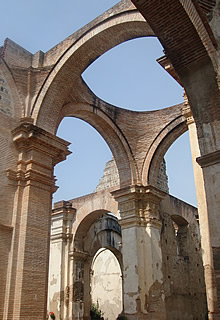
The seventeenth century cathedral stands on the east side with the more atmospheric ruins, with some reconstruction, of an earlier cathedral, behind - a result of the earthquake in 1773.
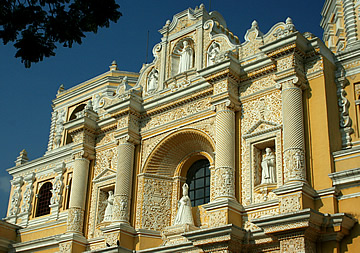
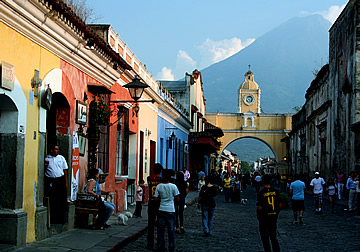
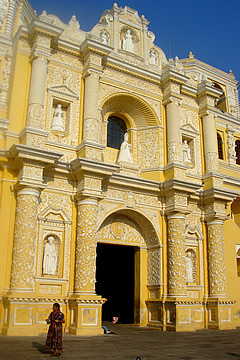
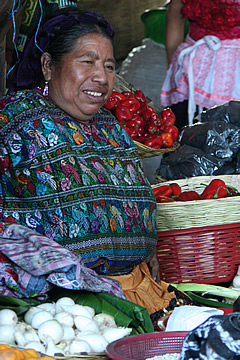
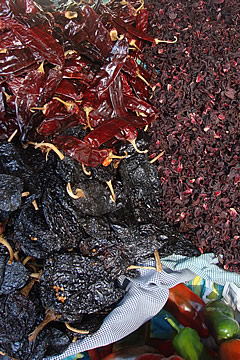
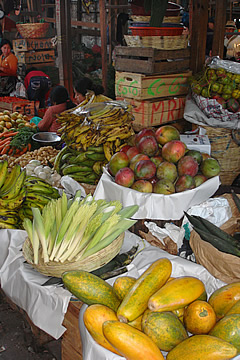
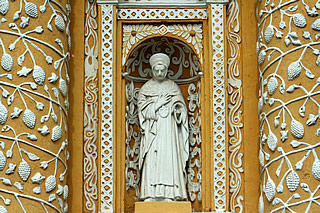
North from Parque Central the Santa Catalina Arch spans Avenida 4 Norte - all the north south roads are numbered Avenida and the east west roads are numbered Calle; north, south, east or west of Parque Central. The arch once connected the convent of Santa Catalina with a school on the opposite side of the road so that the nuns could get from one to the other without going outside.
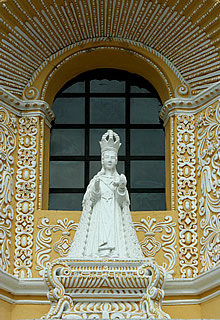
A little further north through the arch is the attractive church of La Merced. Built in the seventeenth century to withstand earthquakes, its white and yellow facade is dazzling in the evening sun, its Spanish churrigueresque one of the more attractive manifestations of baroque, very reminiscent of the Plateresque style of Salamanca.
We really enjoyed eating at Hector's, near La Merced - fantastic meat, perfectly cooked.
We were lucky to be in the city on a big market day, Thursday. It's extremely colourful and many of the women still wear traditional dress - the most beautiful hand-woven and embroidered materials used in blouses with exotic birds and flowers being favourite subjects.
It is held in a big covered market hall but spills outside - the displays of exotic fruit are mouth-watering.
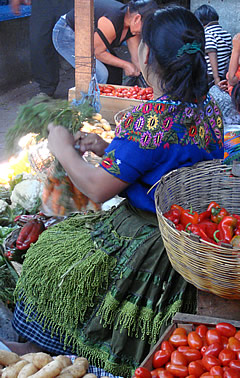
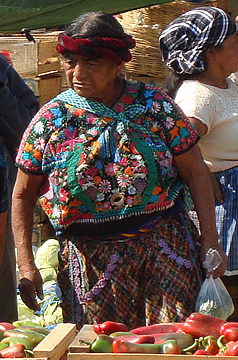
Nearby the bus station is another riot of colour as all the buses are wildly decorated! Lots of the buses look as if they are old US school buses.
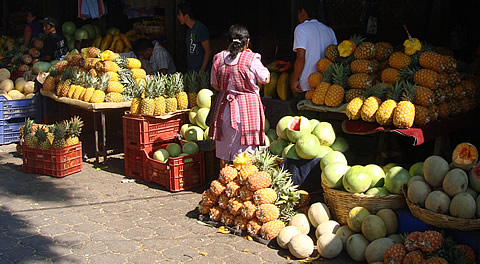
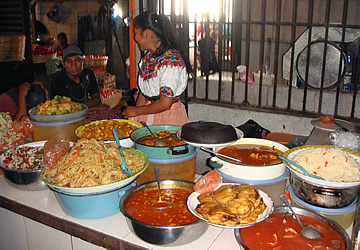
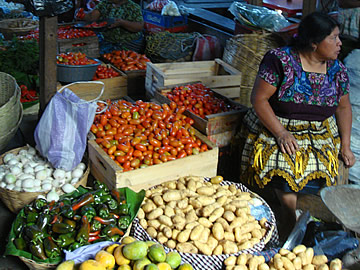
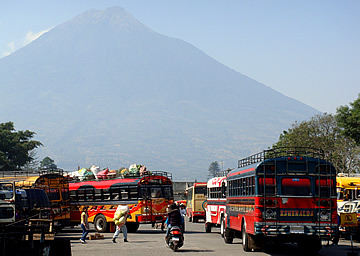
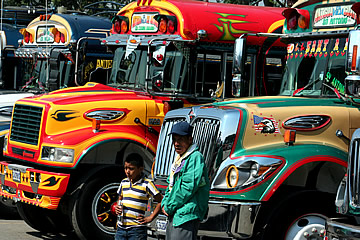
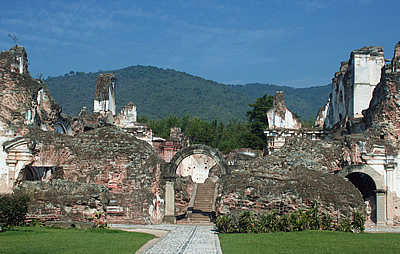
North of the Market are the ruins of San Jeronimo and then west the atmospheric ruins of the Convent of La Recoleción.
La Recoleción was built in the first decades of the eighteenth century but was almost immediately damaged by an earthquake and then almost completely destroyed in the earthquake of 1773. It too, early in the morning, is very peaceful, huge blocks of masonry litter the grounds set in lovely lawns. We were too early and contented ourselves with looking from the entrance but the caretaker was hacking back bougainvillea nearby and offered to open it early for us.

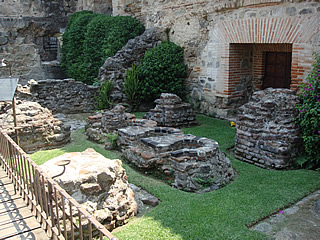
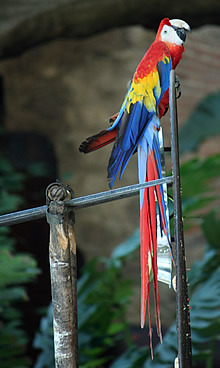
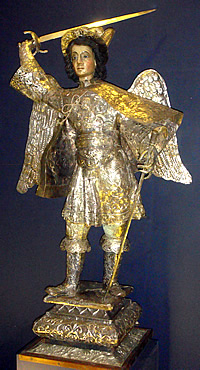
Casa Santo Domingo was an important Dominican Monastery, now the site is home to a museum and ruins of the monastery buildings as well as various small museums.
There are Scarlet Macaws in the grounds, though some look as if they've been pulling their feathers out. There are the remains of domestic areas as well as religious buildings. Lots of bones and skeletons in the crypts.
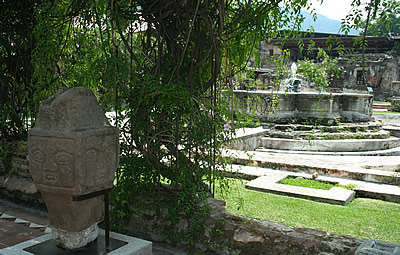
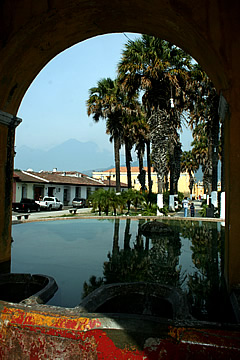
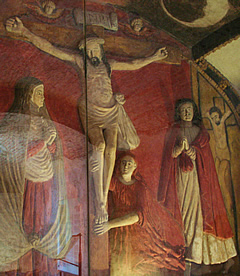
Excavations in 1996 uncovered a colourful seventeenth century painted sculpture of Christ on the cross, with the Virgin Mary, Mary Magdalene and John the Baptist. The vault in which it was found had been filled with rubble but in such a way that the walls and this work of art were untouched. It is now encased in glass and well cared for.
There are lots of ruined ecclesiastical buildings in the city but one of the nicest things we saw was purely domestic - a public laundry.
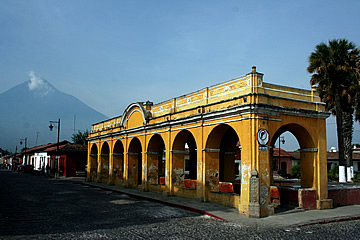
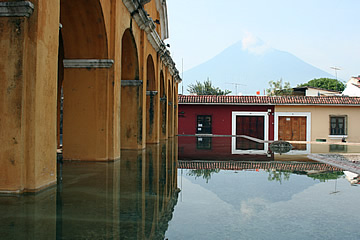
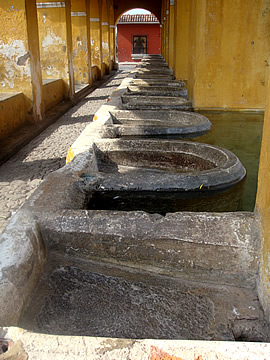
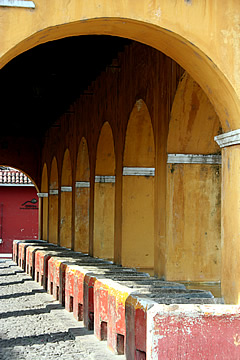
I don't know how old it is but it is fully intact and laundries such as this are still in use. This is a rather grand affair with a covered series of basins each with a slope, a small hemispherical dip in the front right hand side - presumably for soap - and a drain at the bottom.
The front face of each basin is curved which would be more comfortable for the women. Behind the length of the basins is a big pool of water into which they drain. It looks like there is a fountain in the centre of the pool, and behind a grove of palm trees with volcanoes in the distance - what a view to do your washing by!
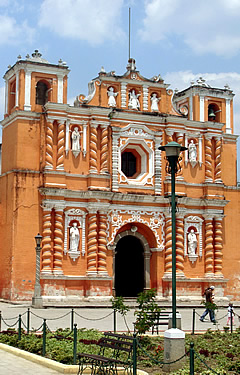
We left Antigua early in the afternoon to drive to Lake Atitlan. Mario, the consummate guide, asked if we'd like to see a little-visited Mayan site on the way to which we readily agreed.
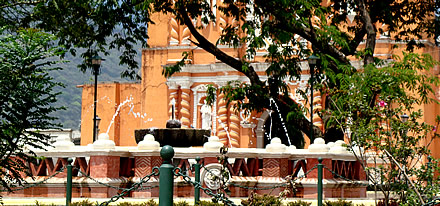
As we drove north out of the city Mario stopped to show us the beautiful early seventeenth century church in Jocotenango which positively glowed.
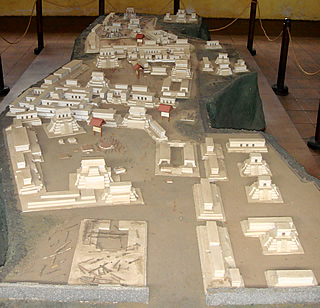
The Mayan site that Mario wanted to show us was Iximche, a post-Classic site dating from 1470. Mesoamerican civilisation is divided into pre-Classic upto about 300AD, Classic until 900AD and post-Classic from 900AD to the Spanish conquest in the sixteenth century.
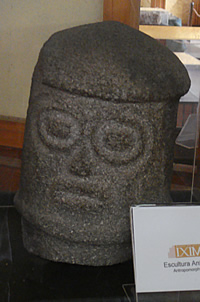
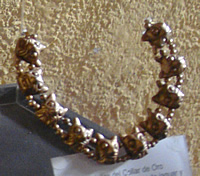
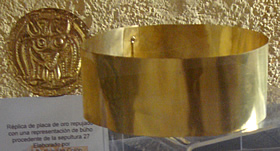
During his conquest of the Guatemalan highlands Alvarado had first made allies of the Kaqchiquel people of Iximche and in 1524 it became the first Spanish capital of the Mesoamerican region.
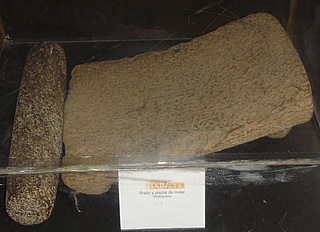
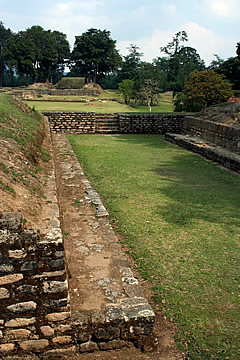
We started our visit in the very small museum which has a model of the layout of Iximche and some artefacts, most interesting of which were a curved stone on three legs with a stone "rolling pin" used to crush grain and a stone head very reminiscent of one we'd seen in the sunken temple at Tiwanaku.
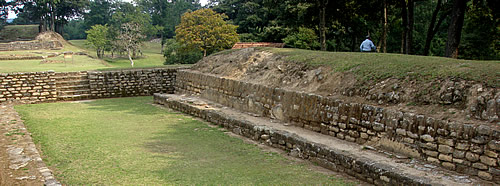
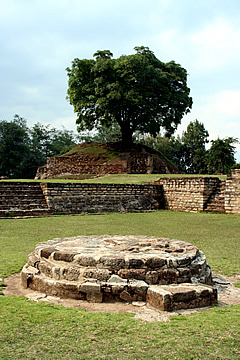
Well over a hundred structures have been located at Iximche, which is composed of four large plazas strung out along a ridge and protected by a deep moat.
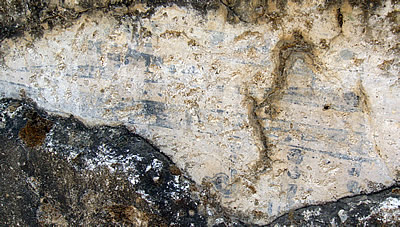
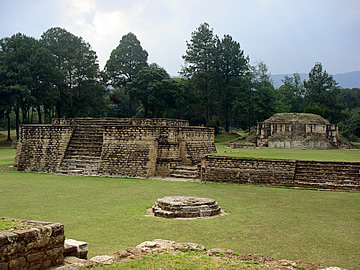
Buildings include palaces, two ball courts, numerous pyramid temples and residences.
It is a very peaceful site and there were no other tourists there when we visited - it's a bit off the usual tourist trail.
There is some reconstruction of the buildings but it is very well done. One ball court is clear to see, rectangular in shape with no obvious room for spectators. Evidence suggests that a rubber ball was used and it does not seem to have had a standard size. It had to be kept in the air using hips, arms or knees but not hands or feet. The game was played by two teams, maybe up to five in each team. Though it may not have been a game at all, possibly it was some kind of ceremony or religious activity.
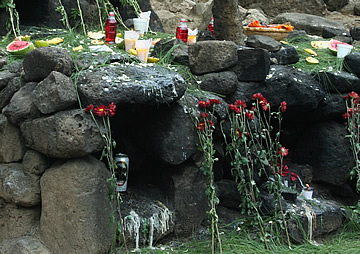
At the far end of the site are a set of altars, one of which is used in present-day Mayan ceremonies - the government has officially decreed that a number of these around the country can be used for traditional purposes. We were really lucky to be there when a ceremony was in progress, conducted by a real Shaman and his assistant. They put all kinds of things on the sacrificial altars: flowers, cut fruit and opened bottles of soft drink, with fires burning in recesses below.
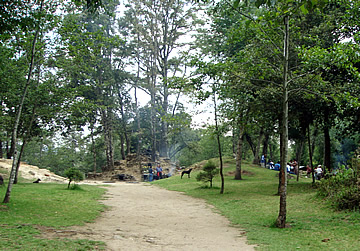
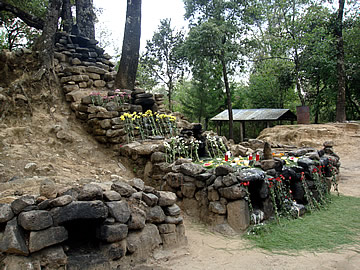
Iximche was the capital city of, and is sacred to, the Kaqchiquel people, who still inhabit the region. In their language, which is still spoken, the name is derived from "Ixim" meaning "corn" and Chée" meaning "tree" and refers to the breadnut tree which was one of their basic foods.
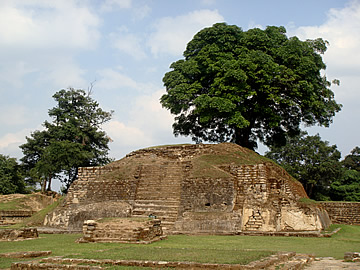
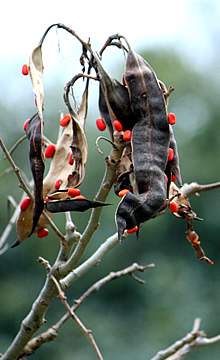
The remains of the fires are tipped into a pit - what a rich source for archaeologists! We were allowed to take discreet photographs after Mario asked permission from the Shaman.
It was a really nice visit with Mario explaining aspects of Mayan life, the birdlife we saw, local trees and their uses on the way. He also showed us traces of paint on a few walls, some very colourful.
We climbed our first temple steps here, very deep and steep, and Mario showed us the diagonal technique which makes it easier. Quite often we found steps seemed to have been built on a scale for people much bigger than us!
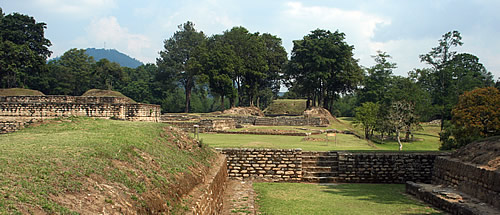
As we left Iximche and drove through the nearby town of Tecpan we saw an old man wearing the typical local dress of white trousers and woollen apron - Mario said that very few of the younger men now wear it.